Understanding the core of your pickleball paddle
To truly understand the pickleball paddle core, it’s essential to grasp the concept of core thickness and its importance in the construction of paddles. Core thickness refers to the measurement from one side of the paddle to the other, specifically in the middle portion where the material interacts with the ball. This aspect of paddle design plays a significant role in determining how a paddle performs in various scenarios during gameplay.
When we delve into the impact of paddle thickness on power, control, and the overall feel of the paddle, we find that thinner cores generally promote faster speeds due to less absorption of energy upon impact. Conversely, thicker cores absorb more energy, leading to enhanced control and touch. Ultimately, the choice of core thickness can dictate a player’s style of play, personal comfort, and confidence on the court. Research suggests that understanding these dynamics can lead players to greater satisfaction in their gameplay, aligning paddle selection with their individual style.
Common pickleball paddle thicknesses
Pickleball paddles typically fall within three core thickness categories: thin core (≤14mm), medium core (14mm-16mm), and thick core (≥16mm). Each category presents unique characteristics that are beneficial for different types of players and playing conditions. The overarching distinction in these categories can guide players in making a suitable choice based on their preferences and skill levels.
- Thin Core (≤14mm): These paddles are lightweight and ideal for players seeking speed and power during rallies. The agility offered by a thin core is perfect for quick exchanges at the net, especially where reflexes are essential. For instance, paddles around 11mm often draw in more aggressive players who thrive on fast-paced exchanges.
- Medium Core (14mm-16mm): A middle ground that balances power and control, paddles in this range provide a larger sweet spot, appealing to a broad spectrum of players, from beginners to intermediates. These paddles help players grow their skills by offering a blend of stability and responsiveness, making them a popular choice among recreational players.
- Thick Core (≥16mm): Catering to players who prioritize touch and precision, thick core paddles generally offer more control and dampen vibrations upon ball impact. Ideal for strategic play and ball placement, these paddles are a favorite among those who favor finesse over raw power.
See more: Top 7 Best 14mm Pickleball Paddles Review in 2025
When selecting a paddle thickness, it’s vital for players to consider their unique playing style and skill level to find the best match for their game.

Thin pickleball paddles: Advantages and considerations
Power and speed
One of the primary advantages of thin pickleball paddles is their ability to generate impressive power and ball speed. Due to their design, these paddles typically absorb less of the ball's energy upon impact, allowing for a more explosive shot. This benefit is particularly pronounced in thin cores, often found in paddles around the 11mm to 13mm range, which empower players to make quick, decisive strikes to end points effectively. For those who thrive on aggression, such as volleying at the net, these paddles can be game-changers.
Aggressive players looking to overpower their opponents will find thin paddles particularly alluring. The ability to generate speed with minimal effort sets the stage for dynamic rallies, where split-second decisions become paramount. The thrill of taking control of the net and dictating the pace of play resonates with many competitive players who appreciate the immediate feedback offered by these lightweight options.
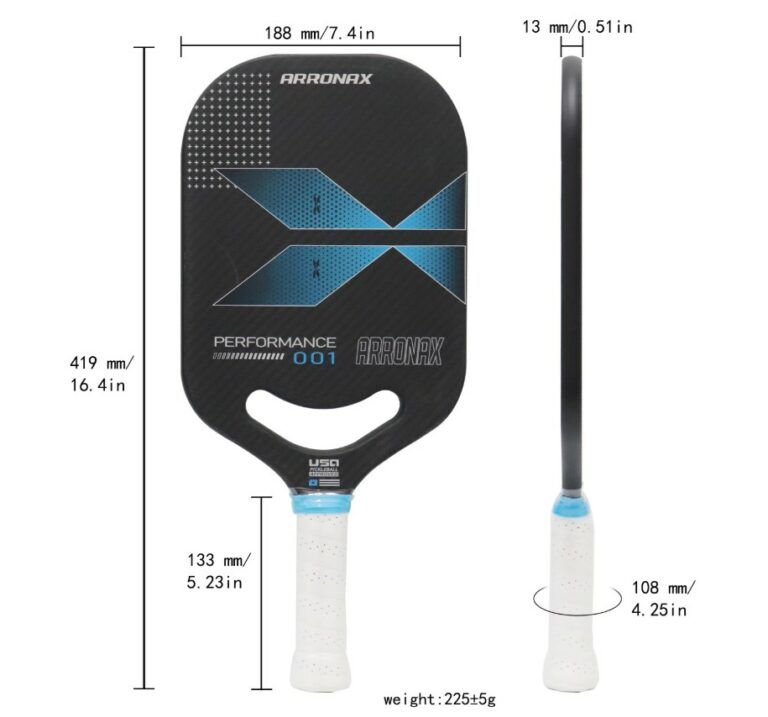
Maneuverability and quick reactions
The lightweight nature of thin core paddles contributes to their extraordinary maneuverability, enhancing a player's ability to react swiftly to fast-paced exchanges. In situations where quick hands are necessary, having a paddle that offers agility can be the difference between victory and defeat. Players benefit from the ease of swing, permitting rapid changes in shot selection to counter opposing plays effectively.
Moreover, lighter paddles can significantly alleviate fatigue during extended gameplay sessions. By reducing the physical strain associated with handling heavier equipment, players can maintain peak performance levels throughout matches, allowing for more consistent play and improved endurance. This emphasis on quick reactions at the net empowers players to assert themselves more effectively and fosters an exhilarating atmosphere on the court.
Considerations for thin paddles
While the advantages of thin paddles are clear, they are not without their drawbacks. One significant trade-off is the control aspect; thinner cores often feature a smaller sweet spot, which can make them less forgiving for novice players making off-center hits. Less experienced players may struggle to achieve consistent results with these paddles, which could lead to frustration during gameplay.
Additionally, players may encounter increased vibration during ball contact with thin paddles. This can sometimes result in discomfort, as the rigidity of thinner models may not absorb impacts in the manner thicker paddles can. Novice players or those recovering from previous injuries should weigh these potential downsides against the benefits to choose a paddle that truly suits their needs.
Thick pickleball paddles: Advantages and considerations
Control and precision
For precision-oriented players, thick pickleball paddles present a wealth of advantages. These paddles, characterized by their significant core thickness, often provide greater control, making them ideal for players focused on finesse, placement, and strategic dinking. The larger sweet spot typically associated with thick core paddles enhances consistency, enabling players to place shots with more accuracy vital for successful dinks, drops, and resets.
As a player familiarizes themselves with the intricacies of pickleball, developing touch and strategic play becomes increasingly essential. The confidence to place the ball exactly where desired can often be found within the realm of thick core paddles, allowing for a calculated game approach and enhanced performance throughout contests.
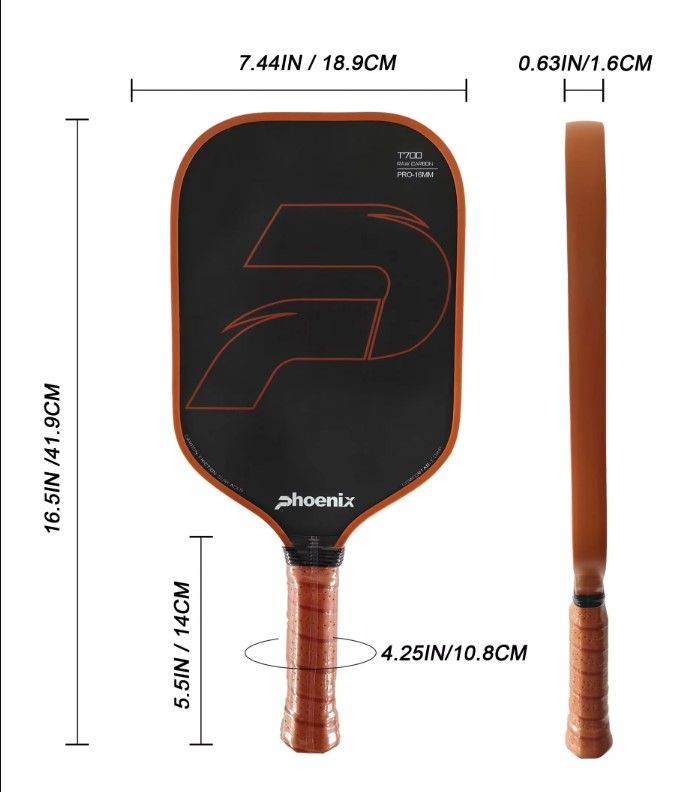
Comfort and stability
Thick core paddles excel in comfort due to their enhanced shock absorption. This characteristic diminishes the jarring vibrations that may be felt upon ball impacts, promoting a more enjoyable playing experience. Reduced vibration not only contributes to overall comfort but also aids in injury prevention, giving players peace of mind while engaging in longer, more intense games.
The stability offered by thicker paddles serves players well who prioritize a softer feel and increased forgiveness. Knowing that minor mis-hits may not substantially detract from their performance allows players to execute shots with more confidence and success over time. The balance between comfort and control offered by thick paddles aligns nicely with the playing styles of many seasoned players pursuing strategic gameplay.
Considerations for thick paddles
However, it is essential to understand the potential downsides accompanying thick paddles. Players may notice a decrease in raw power compared to their thinner counterparts, as thicker paddles can absorb more energy on impact. This characteristic can hinder aggressive play styles that rely heavily on swift, powerful knocks. Moreover, the added weight associated with thick core paddles may slow swing speeds, posing challenges for players accustomed to the lightness of thin paddles.
Choosing a thick paddle is not without its considerations, and players, particularly those transitioning from thinner options, should spend some time adjusting to the differences in feel and maneuverability. Striking the right balance between power and control is vital in deciding the ideal paddle for one’s unique game.
The science of impact absorption: Going beyond power vs. control
How core thickness affects energy transfer
At the heart of paddle performance lies the science of impact absorption and energy transfer. Different core thicknesses directly influence how energy from the ball rebounds through the paddle, affecting both power and control. Thin paddles, by design, experience rapid energy transfer, leading to faster ball movement. However, this quick rebound often compromises touch, as players may find it more challenging to cushion the ball during gentle shots.
In contrast, thicker paddles excel in energy absorption, yielding softer impacts that facilitate better control over shots. A core with a thickness of 16mm or more allows for a nuanced touch, perfect for strategic placements and delicate volleys. By optimizing energy transfer between varied core thicknesses, players can enjoy a tailored experience reflecting their performance goals on the court.
Visualizing these concepts can help players grasp the nuanced dynamics at play. By drawing upon scientific principles relating to impact and energy dissipation, players can identify how specific paddle characteristics resonate with their performance style. Understanding impact absorption’s role in comfort and injury prevention further solidifies the relationship between paddle choice and player satisfaction.
Matching your paddle thickness to your game
Playing style considerations
Choosing the right paddle thickness can align closely with an individual’s playing style. Aggressive players who rely on strong hits and quick reactions are often drawn to thinner paddles that offer speed and maneuverability. Conversely, defensive players may find thicker paddles better suited to their approach, allowing for higher levels of control and precision during strategic exchanges. All-court players benefit from a balanced approach, integrating various paddle characteristics to optimize their flexibility on the court.
When navigating between singles and doubles play, players may favor thinner paddles in singles matches that favor aggressive attacks while leaning towards medium or thick options during doubles for enhanced control and consistent play. These preferences often derive from the specific demands of the game format, where tactical approaches may shift.
Skill level and paddle progression
As players advance through various stages of skill development, their paddle preferences may evolve as well. Beginners often find that thicker paddles provide a more forgiving experience, enabling them to build confidence without the risks associated with less forgiving thin models. As players enhance their skills, the transition to thinner paddles becomes preferable, complementing their growing abilities to make precise shots and control the game.
Understanding how paddle thickness recommendations can shift throughout a player's journey allows for strategic decision-making in paddle selection. By recognizing a player’s path from novice to advanced skill levels, they can align with best pickleball paddle suit their growth potential in the sport.
Personal preference and testing
Ultimately, personal preferences play a fundamental role in paddle selection. As with many sports equipment choices, the best way to discover what works is through experimentation. Trying out various paddle thicknesses, engaging in demo programs, and reviewing detailed paddle analyses become key in determining the most suitable fit.
Additionally, various resources, such as expert consultations and peer reviews, can provide valuable insights into the benefits and shortcomings of specific paddles, creating an informed understanding that leads to sound decision-making. The subjective nature of comfort and performance emphasizes the need for tailored testing, aligning with each player's unique playing style and preferences.
Additional factors to consider
Paddle face material and spin
Beyond core thickness, the choice of paddle face material can significantly impact the overall playing experience. Different materials, such as carbon fiber and graphite, interact uniquely with paddle thickness to generate spin. A textured surface can facilitate improved spin control, enhancing shot execution and overall gameplay.
The successful interplay between paddle thickness and face material becomes paramount, as players seek that perfect blend to amplify their spin capabilities and maintain desirable ball control while playing. Understanding how these aspects correlate to performance can optimize a player’s experience on the court.
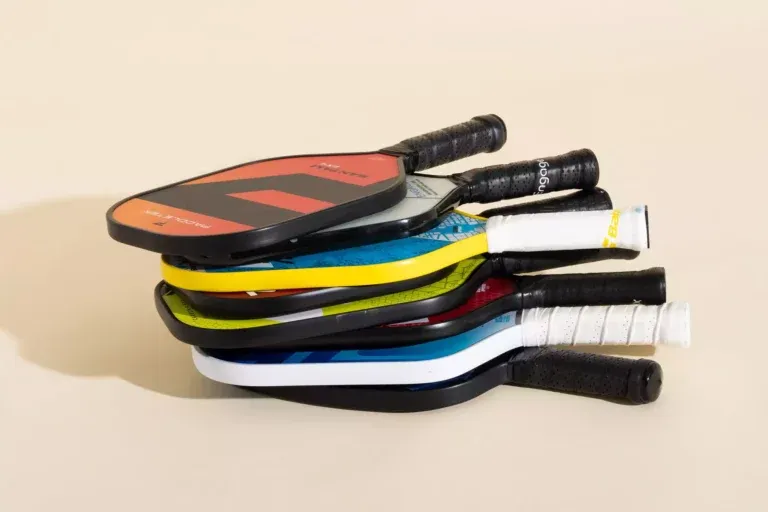
Grip size and handle length
Proper grip size and handle length can make a considerable difference in terms of comfort and control. Selecting the appropriate grip size and ensuring the right handle length complements a player’s palm size and playing style. Resources like grip size charts guide players in making educated decisions, ultimately contributing to injury prevention and comfort during intense play.
A comfortable grip allows players to maintain better control over their shots, enhancing performance in crucial moments. This consideration is particularly relevant as players choose paddles that align with their tactile preferences and physical requirements.
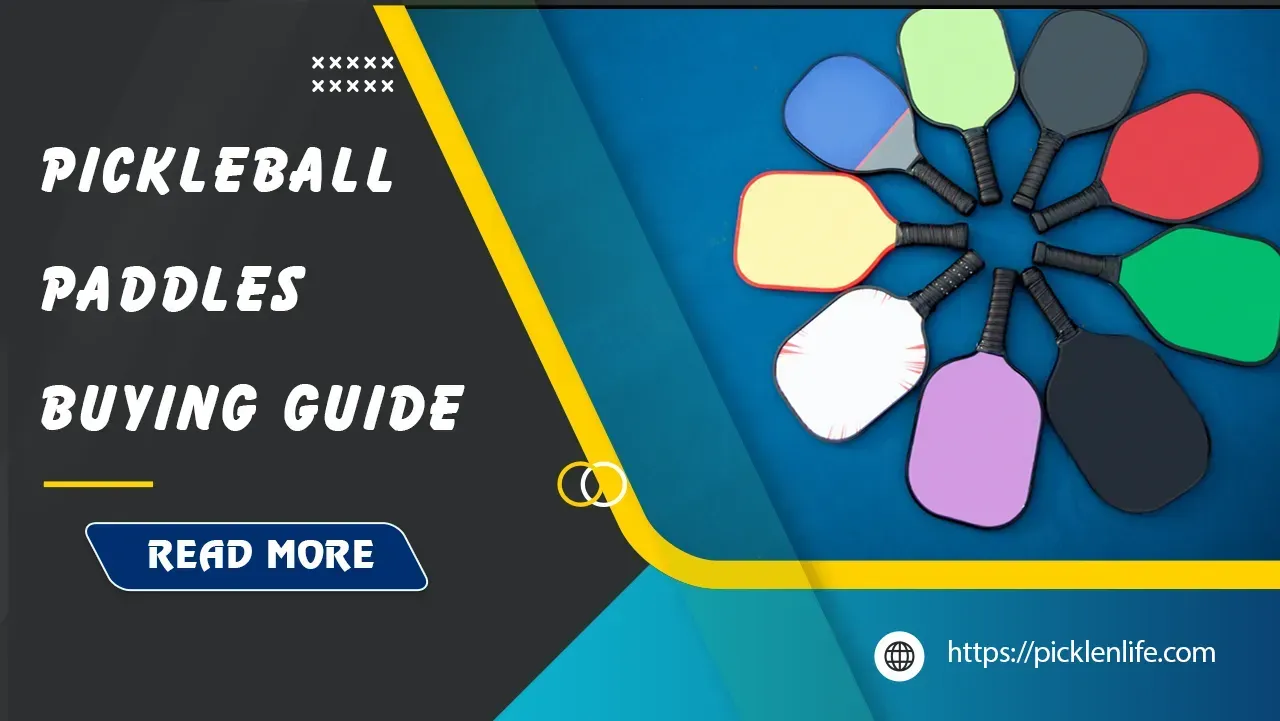
Weight and balance
Lastly, understanding and adjusting the weight of a paddle through static weight and swing weight concepts is essential. Core thickness affects weight distribution, where the balance of power and maneuverability comes into play. Players can manipulate their paddle weight using lead tape to fine-tune their equipment, ensuring the ideal combination of stability and ease of swing.
Prioritizing awareness of how core thickness impacts weight and balance keeps players in control, contributing to consistent, powerful performance while maintaining that critical agile edge in their game.
Beyond 13mm and 16mm: Exploring other thicknesses
While 13mm and 16mm paddles often dominate discussions, exploring 14mm and 15mm models can yield interesting options that suit various playstyles. For instance, the 14mm range offers players a blend of power and stability, while 15mm provides a unique advantage for those seeking a subtle balance between finesse and aggression. The growing variety of options means that players can explore beyond conventional categorizations, potentially discovering a remarkable paddle that perfectly aligns with their individual preferences.
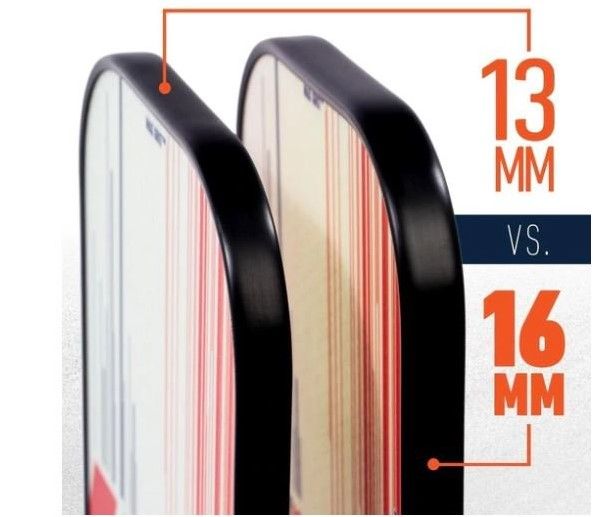
See more: 14mm vs 16mm Pickleball Paddles Comparison: Pros and Cons Explained
Conclusion: Finding your perfect pickleball paddle
As we delve deeper into the intricate world of pickleball paddle thickness, several key takeaways emerge regarding power, control, feel, and overall performance. Understanding the attributes of thin, medium, and thick core paddles empowers players to make informed choices tailored to their unique playing style and skill levels. By experimenting with different thicknesses, engaging in demo programs, and seeking advice from experts, players can navigate their options with greater confidence and enthusiasm. Ultimately, discovering the right paddle can enhance your enjoyment and performance on the court, helping you elevate your game to new heights.










